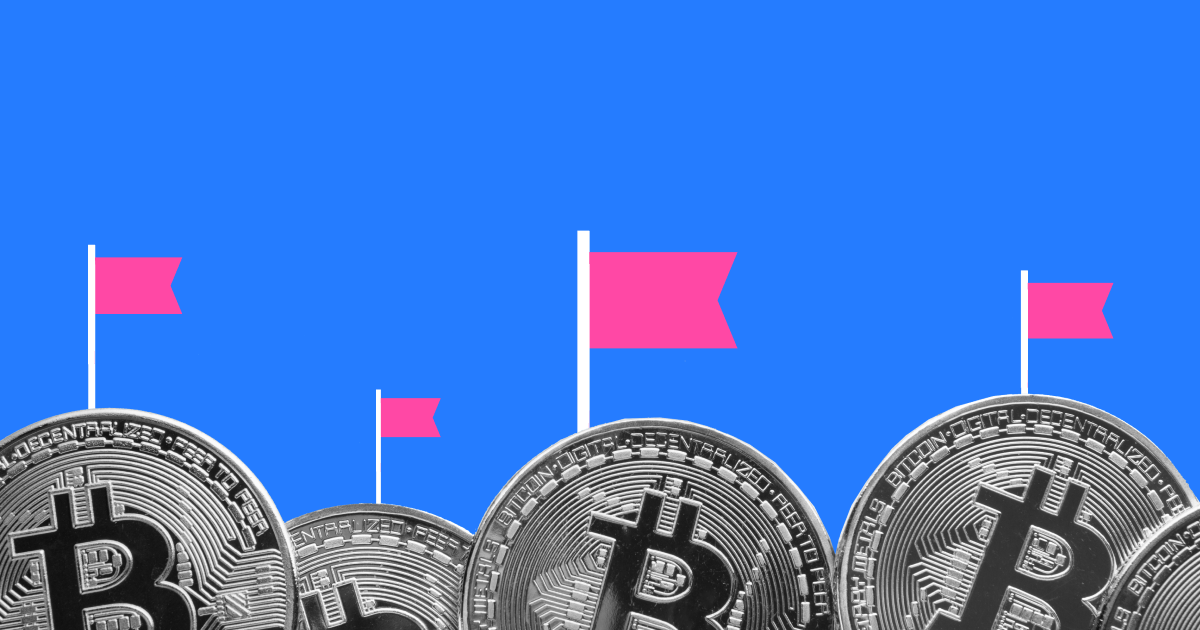Q1 2025 Market Report This report will cover all the shifts that...

Cryptocurrencies have become a synonym for a lush earning opportunity. So many success stories of getting rich through crypto trading may trick people into believing buying a coin is enough to start reaping wealth.
Considering there have been 20,000+ cryptocurrencies, selecting what to invest in has turned into an undeniable challenge. Add to that the absence of regulation, new crypto projects constantly emerging, and the gullibility of uneducated traders, the cryptocurrency market has become fertile soil for scams.
The best way to avoid falling for crypto fraud is to educate yourself. Do your due diligence, research the project, double-check everything, and watch out for crypto red flags.
Keeping your head cool and combating FOMO when everyone is hyping about a new project might be tough, but it will save you both cash and nerves. Speaking of red flags, how are you to know what to pay attention to?
Table of contents
Although it can be aggravating to Google every single thing about a crypto project, it’s a necessary first step. The first logical thing to check is the blockchain’s website. You would normally want it to be neat, easy to navigate, and transparent. You should be able to find all the necessary information in just a few clicks, without having to browse all over the website.
Now, what are the crypto red flags to keep an eye on here? Some of the scam-screaming indicators include:
The next thing you’d want to examine is the whitepaper. It should provide all the necessary data about the crypto project so that prospective investors get an idea of whether it’s worth investing in. If it’s too general or even worse, plagiarized (you can check this using a plagiarism tool), you should stay away from this project.
Wise people once suggested taking big promises with a grain of salt. In the crypto ecosystem, if something seems too good to be true, then it probably is. Take heed of claims and offers that promise bombastic rewards without being able to support them.
To illustrate, if you stumble upon an ad claiming you’ll make a 10% or even 100% return on your investment in no time, consider it a massive crypto red flag. In fact, it’s advisable that you remain skeptical of any project promising guaranteed returns, notwithstanding the investment amount. The same applies to high yields as well.
If crazy staking amounts are offered such as 10%, 20%, 50% or a whopping 1000% for staking coins, it’s usually unsustainable. You should always check the numbers and calculation of the offered yield.
Another instance is a project that alleges to have built a “new and improved” blockchain technology which is way more exceptional than any of its competitors. Unless the team behind the project is capable of backing up the claims with evidence, avoid investing in it at all costs.

Investing in crypto is risky for several reasons. The market is relatively new and unstable, and cryptocurrencies are volatile, i.e., prone to erratic value fluctuations. Owing to this, it’s advisable that you carry out your own cryptocurrency risk assessment.
On the platform’s end, the potential risks should be clearly stated on its website so that customers can become aware of possible investment risks. Failure to reveal the dangers may indicate that the platform is engrossed solely in making a profit, ignoring the well-being of their customers.
Before investing in crypto, check whether it’s listed on respectable exchanges. If you’re struggling to find it, you may want to reconsider your investment. One of the alarming signs is excluding a cryptocurrency from the list of digital assets on trustworthy platforms. The reason for this lies in the fact that the listing demands legitimate paperwork for registration, which they don’t have.
Keep in mind that you should be cautious of exchanges as well. Any crypto platform requires you to provide a whole bunch of confidential data such as your name, place of residence, and credit card credentials.
At some point, your funds and earnings will be stored in there. Therefore, you’ll want a crypto exchange to be registered and to fully comply with the regulations of the country where it operates. Similarly, opt for onshore platforms as opposed to offshore platforms, as the latter raise cryptocurrency AML red flags, since you don’t want to be a part of a money laundering scheme.
The lack of registration and regulation implies that your funds are unprotected. Should anything bad happen, you risk losing your money for good. Plus, if such exchanges carry out any misconduct, it may result in devastating consequences for customers.
This is precisely where the necessity for regulation kicks in as it’s critical for holding exchanges accountable for any malpractices. After all, if you wouldn’t trust an unregulated bank, why would you do so with an unregulated crypto platform?
Yes, Bitcoin was created by a pseudonymous individual (or individuals) Satoshi Nakamoto. Staying anonymous in the crypto realm can make sense in the name of decentralization. However, though the creator is anonymous, the team of developers behind Bitcoin isn’t.
The team behind a crypto project may disclose more information than you might initially think. Understanding who the team members behind the project are gives you an opportunity to conduct research as part of the cryptocurrency risk assessment. The research could expose if they previously worked on other projects, or were involved in scams. In case they were, you would want to skip this project and focus on another worthy of your time and money.
Celebrity endorsements aren’t uncommon in the crypto realm. Just remember Elon Musk constantly tweeting about Dogecoin (DOGE), and driving its price to new highs. Celebrity or influencer marketing is a common promotion method, especially when it comes to new coins and tokens.
However, if a company fails to disclose other relevant data, such as developers behind the project, it could be a crypto red flag.
Investing in crypto only because a celebrity endorses it is no good. Rather than believing their promotions and promises, check the cryptocurrency’s fundamentals — its mission, competitors, and how it secures the network. You should also check its use case. If there is no real use case, i.e., the problem it solves, then it’s certainly a bad sign.
And don’t immediately believe everything you read. Double-check the info you’ve found in different sources. It might be time-consuming, but it’s a necessary step toward making sure your money is in safe hands.
A Ponzi scheme refers to an investment scam where old investors receive gains brought by novel investors. For instance, picture a business promising people they have an opportunity to double their profit within quite a short period of time.
The only thing they need to do is invest a specific amount of money and wait. The cycle goes on until the organizers aren’t able to bring new investors. At that point, they flee with the investors’ money, making the whole scheme crash.
Such schemes are screaming crypto red flags. Sadly, there have been so many of them and numerous people have fallen victim to such fraud that it’s not surprising why laymen think crypto is all Ponzi schemes. To avoid such scams, always invest directly with a trustworthy cryptocurrency exchange and in reliable coins.
Don’t trust people hitting you in DMs with their success stories promising you can earn certain amounts if you invest with them. These are all fraudsters trying to get you tangled in their web of scams only to run away with your money.
Cryptocurrency risk management implies that you invest in digital assets with your head cool, guided by reasoning, not emotions. Scammers, however, don’t want you to do this. They’d rather urge you to purchase or invest as soon as possible. And they will be pretty persistent in their calls or messages. You need to act immediately, otherwise, you’ll miss out and lose a chance to profit.
Don’t buy into such warnings and pressure. Before investing in any digital asset, you should take as much time as you want to conduct all the necessary research. FOMO (Fear of Missing Out) and emotions, in general, are your greatest nemesis when it comes to crypto trading and can seriously impact your potential of making a profit.

Token distribution refers to the manner in which tokens are allocated between investors. Distribution models may vary, but the most traditional ones include airdrops and lockdrops, venture capital, public sales, and rewards. They can be free (airdrops and lockdrops) or paid (public sales and venture capital). Any other models that stray away from these conventional are considered crypto red flags.
For instance, you should never ever pay even a cent for a crypto airdrop. They are mainly free or may require a small favor such as sharing a post on social media. Promising an astronomic reward is also alarming. Anything that seems too good, off, or suspicious is most likely a sign of a scam.
It’s important also to carefully examine the vesting schedule of tokens before investing. Large token unlocks in the near future can cause a sharp drop in token prices, as private investors who acquired tokens at lower prices may decide to sell their coins. Such large unlocks within the first few months are a significant red flag for investors, and it’s important to stay vigilant of the vesting schedule to make informed investment decisions and avoid potential losses
Credible cryptocurrency exchanges are open about their fees. Whenever you’re conducting a trade, you’ll know the amount of fee that will be charged to your account. Those charges aren’t the same for every cryptocurrency.
They typically depend on factors such as network congestion, transaction size, and confirmation time. For this reason, you’ll pay less fee for purchasing USDT compared to BTC. But whichever crypto you’re buying, you’ll know in advance how much you’ll be charged.
Hiding fees and charging additional costs are obvious red flags for dishonest behavior. Prior to registering at an exchange, examine their fee structure. If the information is missing, look for another crypto platform. If it’s unclear if and how much you’ll be charged for deposits or withdrawals, invest your money elsewhere.
Watching out for crypto red flags may indeed be tedious, even overwhelming when you’re just starting out. However, being cautious and doing lots of research is more than necessary for beginners, as knowledge can save you from being a victim of a scam. Once you master these red flags, you’ll be able to immediately recognize crypto fraud and shift your focus to something worth your time.
If all these seems too troublesome to do it on your own, feel free to contact us. Our experts will advise you on what legitimate exchanges to register at and what projects are worth investing in.
Latest Articles
Veli is Going for the MiCA License! A new era in compliance...
Over 100 New Coins Added to the Veli Platform! 🚀 Earlier this...